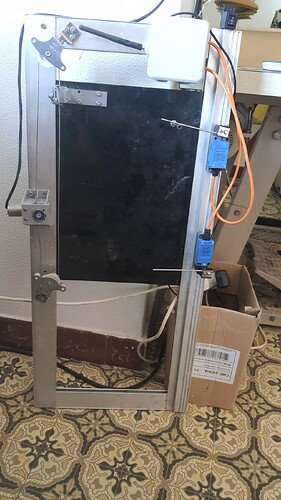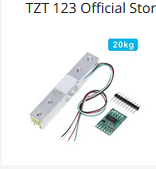Hi everyone!
This is my second post, and I want to share my project. It is a simple chicken door that works with a normal motor. I decided to share because I found a lot of projects that work with stepper motors, but I could’t find any that works with a normal motor. I hope that this post will help someone in the future!
Here I go! (And please, if someone finds something that I should edit, please tell it. I only want to contribute the best I can)
1. The problem
I have chickens, and I have to open and close them the door every day. So, why don’t make them a smart door?
Conditions:
- It is mandatory for this door to work every day and every night. It can’t be left open any night.
- Chikens don’t have a decent internet conection, so this project should be able to work without any internet conection
- The least component it takes, the cheaper it results!
2. The microcontroller
The first decision was choosing a microcontroler. Because of contidion #2, I should choose a microcontoler with a decent wifi antenna. So, I choose an ESP32 cam.
This microcontroler has a built-in antenna, but it also has a IPEX connector for a more powerfull one, so this was a good point. To do this, I had to change the small resistor near the IPEX connctor. I followed this guide, it is very well explained:
Now I have a controller with a few GPIO and a good wifi connection. It was time to think about the electronic design.
3. Other components
As I mentioned on the title, I also used a DC motor, one H-bridge, two limit switches, a buck converter and a DS1307 RTC module. This RTC was included because of condition #1 and #2, just in case of internet communication failure.
Here are the BOM. Note that links are only posted for reference, I already had all this stuff at home. Please search for a better price!
1x ESP32 CAM
1x DC Motor
1x DRV8871 H bridge
1x LM2596 Buck converter
https://www.pixelelectric.com/electronic-modules/voltage-regulator/buck-converter-step-down/lm2596-dc-dc-buck-converter-step-down-power-module/
1x DS1307 RTC module
2x Limit switch ME-8107
3. Electromechanic design
Before I begin, I must say that I am a mecanical engeneer. Usually, we aren’t very friendly to electronic designs, so my plan was to connect things together with wires, and maybe a resistor or two, and let them make the work. But it is working, so I’m happy with it ![]()
#3.1 Power design
At first, I wanted to power this door with a 5V 3A power supply, and a boost converter. But I had brownout problems, and thanks for the community advice, I changed to a 12V 4A power supply. I power the ESP through a Buck converter, and now it works like a charm.
Here is the link to my original post, if someone is curious:
3.2 ESP GPIOs
On the microcontroller side, I needed 2 GPIO for switches and 2 GPIO for binary sensors. In order to avoid any straping pins warnings, I choosed this ones:
- Open door → 13
- Close door → 33
- Door openned → 14
- Door closed → 4
- I2C SDA → 1
- I2C SCL → 3
Important note: I choosed this set because I tried others (2, 12, 15, 13, 16…) and I got problems, so I suggest this ones
Important note 2: In order to safely use GPIO 4, you should remove the built-in flash led for the camera.
Important note 3: GPIO33 is not easily accesible. You have to weld either on the 9th module pad or on the possitive side of the led. Here are the schematics:
I suggest to weld on the microcontroller pad. It has a little more space and weld seems stronger.
3.3 Circuit design
For safety reasons, I decided to route the connection between the ESP and the H-bridge through the limit switch. Doing this ensures that the motor will stop when it reaches any limit switch postion, so the door protects itself.
The rest of the connections are really simple:
- ESP switch open door → Limit switch #1 NC → H bridge IN1
- ESP switch close door → Limit switch #2 NC → H bridge IN2
- ESP 3V3 source → Limit switch #1 NO → ESP sensor door open
- ESP 3V3 source → Limit switch #2 NO → ESP sensor door closed
- ESP SDA → RTC SDA
- ESP SCL → RTC SCL
(I am working on a “formal” schematic. Now I only can post this draft I draw by hand. The RTC is not shown here):
Note: On my design I included two pull-down resistors because I wasn’t aware of INPUT_PULLUP. I think that they can be eliminated with anoter configuration, but this was my make ![]()
4. The code
I wanted the door to open when sun rises and to coles when it falls. So, I needed a time component, a sun component and a cover component. Here is mi configuration:
esphome:
name: portagali
friendly_name: Porta Galineiro
on_boot:
then:
# read the RTC time once when the system boots
ds1307.read_time:
i2c:
sda: 1
scl: 3
scan: true
id: bus_a
time:
- platform: homeassistant
id: hora_homeassistant
timezone: "Europe/Madrid"
on_time_sync:
then:
# ... and update the RTC when the synchronization was successful
ds1307.write_time:
- platform: ds1307
timezone: "Europe/Madrid"
# repeated synchronization is not necessary unless the external RTC
# is much more accurate than the internal clock
update_interval: never
esp32:
board: esp32cam
framework:
type: arduino
# Enable logging
logger:
level: DEBUG
debug:
update_interval: 1min
# Enable Home Assistant API
api:
encryption:
key: "It is a secret :)"
ota:
password: "This is another secret :)"
wifi:
#fast_connect: True #So vale cunha soa network
networks:
- ssid: !secret wifi_ssid2
password: !secret wifi_password2
# O 3 é Cacharrada
- ssid: !secret wifi_ssid3
password: !secret wifi_password3
manual_ip:
static_ip: 192.168.1.11
gateway: 192.168.1.1
subnet: 255.255.255.0
dns1: 192.168.1.1
dns2: 8.8.4.4
# Enable fallback hotspot (captive portal) in case wifi connection fails
ap:
ssid: "Galineiro Fallback Hotspot"
password: "Galiñeiro"
captive_portal:
web_server:
port: 80
text_sensor:
- platform: debug
device:
name: "Dispositivo"
reset_reason:
name: "Ultimo reinicio por"
- platform: wifi_info
ip_address:
name: Direccion IP
ssid:
name: Nome da rede
scan_results:
name: Redes Dispoñibles
sensor:
- platform: sun
type: elevation
name: Elevación solar
id: ElSol
- platform: debug
loop_time:
name: "Tempo de bucle"
#Controladores, cara o drv do motor. Pines 13 e 33
switch:
- platform: gpio
pin: GPIO13 #12 #GPIO2
name: "Abrir galiñeiro"
id: abrir_gali
interlock: cerrar_gali
internal: True
- platform: gpio
pin: GPIO33 #15
name: "Cerrar galiñeiro"
id: cerrar_gali
interlock: abrir_gali
internal: True
# Sensores, desde o final de carrera NO. Cando a porta chega ao final de carrera, accionase, e desde o com chega unha señal que fai que pare. Ao mesmo tempo, o final de carrera desconecta o abrir.
binary_sensor:
- platform: gpio
pin: GPIO14 #1 #4 2 no va, 13 no va, 16 no carga. Quitar o led
name: Galiñeiro Aberto
id: gali_aberto
#Estes controles son para actualizar o estado. Non andar a tocar os finales de carrera, por favor
on_press:
then:
- cover.control:
id: PortaGali
position: 100%
- platform: gpio
pin: GPIO4
name: Galiñeiro Cerrado
id: gali_cerrado
#Estes controles son para actualizar o estado. Non andar a tocar os finales de carrera, por favor
on_press:
then:
- cover.control:
id: PortaGali
position: 0%
sun:
latitude: 42
longitude: -8
id: sol
on_sunrise:
# Primeiro, a condicion de abrir. Se todo vai ben, abrese e detectase polo final de carrera
- elevation: 0.5°
then:
- switch.turn_on: abrir_gali
- logger.log: "Gali abrindo automatico"
# Se o final de carrera non detectou, entonces baixamos un pouquiño, esperamos e volvemos a subir. Se non vai, repetimos. Para eso está o while
- elevation: 0.8°
then:
- while:
condition:
not:
binary_sensor.is_on: gali_aberto
then:
- cover.control:
id: PortaGali
position: 90%
- delay: 5s
- switch.turn_on: abrir_gali
- delay: 5s
- logger.log: "Apertura fallida. Reabrindo..."
on_sunset:
# O mesmo para cerrar. Á noite, cando empece a faltar claridade, cerramos. Se todo vai ben, non facemos mais
- elevation: -2°
then:
- switch.turn_on: cerrar_gali
- logger.log: "Gali cerrando automatico"
# Pero se o fdc peta, temos un while moi majo que nos abre un chisco e nos volve cerrar
- elevation: -2.3°
then:
- while:
condition:
not:
binary_sensor.is_on: gali_cerrado
then:
- cover.control:
id: PortaGali
position: 10%
- delay: 5s
- switch.turn_on: cerrar_gali
- delay: 5s
- logger.log: "Peche fallido. Recerrando..."
cover:
- platform: endstop
name: "Porta Gali"
id: PortaGali
open_action:
- switch.turn_on: abrir_gali
open_duration: 30s
open_endstop: gali_aberto
close_action:
- switch.turn_on: cerrar_gali
close_duration: 30s
close_endstop: gali_cerrado
stop_action:
- switch.turn_off: abrir_gali
- switch.turn_off: cerrar_gali
Change the wifi, home assistant, and encriptation setting according to your setup. Probably you should also edit sun location and cover times. And probably you can get rid of the debug component and debug text sensor. But this code works.
(Sorry for the coments. They are written in Galician, because at first I didn’t think on sharing my project. If someone needs help, tell it to me)
Note: Someone might notice the two Whiles inside the sun component. They have a reason. Sometimes, the door closes properly, but the limit switch doesn’t send the signal to the ESP. These whiles moves the door a little up or down and closes or opens it again. It is only for sensor purposes.
And here is the result. The last 144 hours it worked like a charm (now it is summer and the days here are longer than the nigths):

And here is the door itself:
- All the electronics is inside the sealed box on the top
- The frame is built with a recicled window frame
 .
. - The limit swithches are triggered with a long screw:
- The motor is supported with a 3D printed support and a 3D printed pulley. If someone is interested, I can put the 3D files on thingiverse.
- Pulleys are recicled clothes rope pulleys
- The orange cables are 4-wire signal cable. They are connected to the ESP throug a screw connector
- The rightest top black swich is a completely manual switch. It manually activates the H-bridge just in case the ESP dies.
And there is all! I hope this post will help someone in the future!
Thank you for reading!!! Greetings from Galicia!!!






